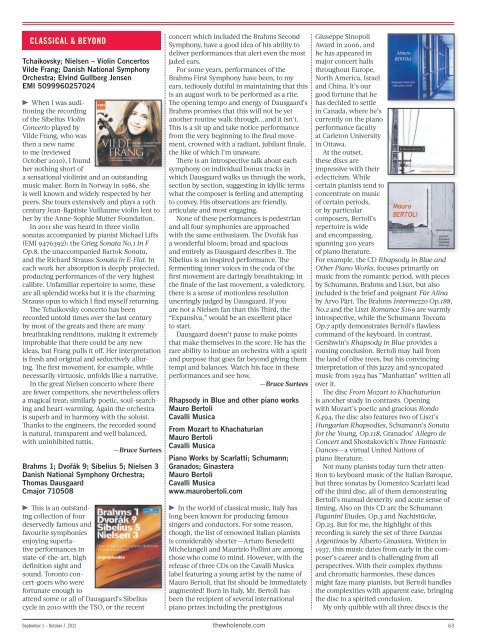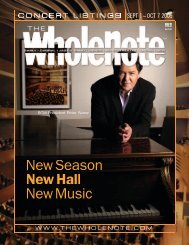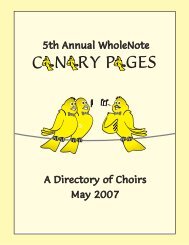flute concerto, two sonatas and one concertofor violin, and four arias from the operaL’inganno trionfante in amore.The CD opens with an exuberant fluteconcerto titled “Il Gran Mogol,” found inEdinburgh in the archives of the 18th centuryamateur flutist Lord Robert Kerr. The violinsonatas (from the Foundling Museum inLondon) and concerto (found in Dresden)are exciting, virtuosic and inventive works.The opera arias date from around 1725, whena documented performance of L’ingannotrionfante in amore took place in Venice.These arias, from a score long thought lost,turned up in 1995 in the Royal Libraryof Belgium!The performances on the disc are of auniformly high quality, with special mentiongoing to the brilliant transverse flute playingof Alexis Kossenko and the fanciful andendlessly varied playing of violinist AntonSteck. Risk-taking like this is imperative tobring Vivaldi’s music off the page.While we are familiar with Vivaldi’s deepimpact on composers such as J.S. Bach, thisrecording is another reminder of how widereachingVivaldi’s influence was acrossEurope in the early 18th century.—Larry BeckwithGlenn Gould plays BachBruno MonsaingeonSony Classical 88691975049-01/2/3!!It was withtrepidation that Iundertook this reviewof Glenn Gould’s threefilms directed byBruno Monsaingeon.For many musicians,including myself,Glenn Gould wasan icon. We grewup listening to hisprodigious recordings of Bach and othercomposers. In fact, my first contemporarymusic experience as a pre-teen was listeningto the Gould recordings of Schoenberg,Berg, Webern and Krenek. These and theinimitable Bach performances by Gouldinfluenced my future repertoire choices andinspired me to adore Bach. I was mesmerizedby Gould’s intelligence, wit, genius andeffortless charisma in front of the cameraor microphone. The question for me waswhether he would still continue to seducemusically and charm conversationally today.There is an abundance of excellent GoldbergVariations in the market now and witheveryone attempting to be a star on YouTube,being on camera is not necessarily such aspecial event anymore.The first DVD, The Question of Instrument,allayed my fears. Glenn Gould shall remainon his pedestal. This is an excellent andinvaluable clinic in voicing. In spite of theoccasional harsh tone and lots of singing, thecontrapuntal lines always flow naturally withan unerring articulation and precision. Thevoicing feels free and flexible as if being composedon the spot. The levels of dynamics arerich and varied with unique characteristicsthat force you to follow the lines to the resolution.The conversation in this DVD is a mustfor all musicians, teachers, scholars and performers.It is the question of harpsichordor piano.Glenn Gould could have been a lawyerbecause he wins his argument easily. He supportsplaying Bach on the piano. Bach wasinto structure and his music adapts to anyinstrument. Gould also believes that the pianocan get you closest to Bach’s conceptions ofform, structure, harmony and counterpoint.He performs several pieces, demonstratingalternate versions of phrasing and sonority.He discusses various instrumentations thatcan come from one piece and gives relevantexamples. Gould dismisses critics of the pianoby calling their arguments “musicologicaloverkill.” Brilliant, virtuosic music is alsooffered as an argument to favour the pianoover the harpsichord (in spite of Scarlatti’sefforts). To demonstrate, Gould performs theChromatic Fantasia in D Minor and althoughhe calls the piece a “monstrosity” he playedit with emotion and impeccable technique.This is a very improvisatory piece, almost likebackground film music according to Gould,and with his singing he sounded like an operastar with an over the top accompanist from ahorror film from the 40s. This was a momentof welcome levity and reminds us of Gould’scomic acting abilities. He refers to this kindof music as Bach for people who do not likeBach. The other work on his “hit” radar wasthe Italian Concerto, another overplayedwork on student recitals. Gould compared theItalian Concerto to Georgian architecture butinsisted that Handel wrote this kind of musicbetter. In performing this piece Gould saysthat it is best not to destroy the structure withtoo many crescendos and pianistic affectations.For comparison Gould performed theSarabande from the Partita No.6 in E Minor todemonstrate a freer form and showed us differenttempos that all seemed to work. Hisperformance of the entire Partita No.4 in DMajor was a marvel. The ornaments are crispand exciting; the counterpoint is articulateand the voicing impeccable with a tapestry oftexture and touch.The second DVD is called An Art of theFugue and appropriately begins with theFugue in B-Flat Major on the name BACH.Again, what a wonderful masterclass in fuguesfor any musician; everything complicatedis explained with clarity and ease by Gould.The program notes, which are excellent, bythe way, say that Gould rehearsed everything.It doesn’t matter, it still sounds spontaneousand the information is invaluable. Thefugal structures become a dramatic journeythrough harmony, counterpoint and resolution.What a majestic performance and deepunderstanding Gould brings to all the fugueshe performs in this DVD. For those who findfugues boring, listen to and watch this DVD.Highlights include the E Major from Book 2,a cantabile Ricercare, which was also ArnoldSchoenberg’s favourite. Preludes are missingfrom this fugue extravaganza. Gould has somedemeaning comments on the Preludes butgives a nod to the one from the Prelude andFugue in A Major, Book 2. Gould speaks forthe artistic and creative merits of fugal structures.Fugal adventures were not popular inBach’s time. Gould mentions minuets as thehot form of the day. However, Bach turned hisback on this and other forms to borrow conceptsfrom the last 100 years such as Flemishdevotional music. There is a piece in the Art ofthe Fugue which also shows Bach’s far-reachingchromaticism in an infinitely expandingmusical universe. It sounds like Schoenberg.The astonishing and ear-opening commentsand playing inspired me to immediately go tothe piano and play some fugues.What to say about the third DVD TheGoldberg Variations? I enjoyed the introductionwhich showed Gould picking his takesand explaining why he chose them. He alsospoke about his reasons for recording theGoldberg Variations again for the secondtime. He said that the technology of 1955, dueto the lack of stereo and Dolby, invalidatedthe process of the first version. What a coupfor musicians to have Gould’s two versions,but it made me wonder if he had lived wouldhe have recorded it again? The DVD concludeswith the entire performance of theGoldberg Variations.Teary eyed and blissfully involved with themusic, I can only say that Glenn Gould shallremain an icon and a legend with his aweinspiring genius. I know that there are a lot ofrecordings, books and DVDs about him but Ihighly recommend this trilogy.—Christina Petrowska QuilicoEditor’s Note:September marks 80years since Glenn Gould’sbirth and 30 since hisuntimely death just daysafter his 50th birthdayand Sony is releasing anumber of Anniversary Edition CDs andDVDs in the coming months. The first tocome our way is Best of Glenn Gould’sBach, a 2-CD plus DVD set, which includesexcerpts from the historic 1955 recordingof The Goldberg Variations, the ItalianConcerto (mentioned above), English SuiteNo.2 and Partita No.1 among other offerings(Sony Masterworks 88728421762).Dreamers Renegades Visionaries:The Glenn Gould Variations is a two-dayfestival of new work, new interpretationsand new collaborations, fromArgentina, Britain, Canada, China, Croatia,France, Germany, Japan and the USA atConvocation Hall, University of Toronto,September 22 and 23. It features more than50 participants including Canadian luminariesBrent Carver, Adrienne Clarkson,Adam Egoyan, François Girard, NormanJewison and Mark Kingwell to name but afew. Full details are available at www.glenngouldvariations.ca.62 thewholenote.com September 1 – October 7, 2012
CLASSICAL & BEYONDTchaikovsky; Nielsen – Violin ConcertosVilde Frang; Danish National SymphonyOrchestra; Elvind Gullberg JensenEMI 5099960257024!!When I was auditioningthe recordingof the Sibelius ViolinConcerto played byVilde Frang, who wasthen a new nameto me (reviewedOctober 2010), I foundher nothing short ofa sensational violinist and an outstandingmusic maker. Born in Norway in 1986, sheis well known and widely respected by herpeers. She tours extensively and plays a 19thcentury Jean-Baptiste Vuillaume violin lent toher by the Anne-Sophie Mutter Foundation.In 2011 she was heard in three violinsonatas accompanied by pianist Michael Lifts(EMI 9476392): the Grieg Sonata No.1 in FOp.8, the unaccompanied Bartok Sonata,and the Richard Strauss Sonata in E-Flat. Ineach work her absorption is deeply projected,producing performances of the very highestcalibre. Unfamiliar repertoire to some, theseare all splendid works but it is the charmingStrauss opus to which I find myself returning.The Tchaikovsky concerto has beenrecorded untold times over the last centuryby most of the greats and there are manybreathtaking renditions, making it extremelyimprobable that there could be any newideas, but Frang pulls it off. Her interpretationis fresh and original and seductively alluring.The first movement, for example, whilenecessarily virtuosic, unfolds like a narrative.In the great Nielsen concerto where thereare fewer competitors, she nevertheless offersa magical treat; similarly poetic, soul-searchingand heart-warming. Again the orchestrais superb and in harmony with the soloist.Thanks to the engineers, the recorded soundis natural, transparent and well balanced,with uninhibited tuttis.—Bruce SurteesBrahms 1; Dvořák 9; Sibelius 5; Nielsen 3Danish National Symphony Orchestra;Thomas DausgaardCmajor 710508!!This is an outstandingcollection of fourdeservedly famous andfavourite symphoniesenjoying superlativeperformances instate-of-the-art, highdefinition sight andsound. Toronto concert-goerswho werefortunate enough toattend some or all of Dausgaard’s Sibeliuscycle in 2010 with the TSO, or the recentconcert which included the Brahms SecondSymphony, have a good idea of his ability todeliver performances that alert even the mostjaded ears.For some years, performances of theBrahms First Symphony have been, to myears, tediously dutiful in maintaining that thisis an august work to be performed as a rite.The opening tempo and energy of Dausgaard’sBrahms promises that this will not be yetanother routine walk through ... and it isn’t.This is a sit up and take notice performancefrom the very beginning to the final movement,crowned with a radiant, jubilant finale,the like of which I’m unaware.There is an introspective talk about eachsymphony on individual bonus tracks inwhich Dausgaard walks us through the work,section by section, suggesting in idyllic termswhat the composer is feeling and attemptingto convey. His observations are friendly,articulate and most engaging.None of these performances is pedestrianand all four symphonies are approachedwith the same enthusiasm. The Dvořák hasa wonderful bloom; broad and spaciousand entirely as Dausgaard describes it. TheSibelius is an inspired performance. Thefermenting inner voices in the coda of thefirst movement are daringly breathtaking; inthe finale of the last movement, a valedictory,there is a sense of motionless resolutionunerringly judged by Dausgaard. If youare not a Nielsen fan than this Third, the“Expansiva,” would be an excellent placeto start.Dausgaard doesn’t pause to make pointsthat make themselves in the score. He has therare ability to imbue an orchestra with a spiritand purpose that goes far beyond giving themtempi and balances. Watch his face in theseperformances and see how.—Bruce SurteesRhapsody in Blue and other piano worksMauro BertoliCavalli MusicaFrom Mozart to KhachaturianMauro BertoliCavalli MusicaPiano Works by Scarlatti; Schumann;Granados; GinasteraMauro BertoliCavalli Musicawww.maurobertoli.com!!In the world of classical music, Italy haslong been known for producing famoussingers and conductors. For some reason,though, the list of renowned Italian pianistsis considerably shorter — Arturo BenedettiMichelangeli and Maurizio Pollini are amongthose who come to mind. However, with therelease of three CDs on the Cavalli Musicalabel featuring a young artist by the name ofMauro Bertoli, that list should be immediatelyaugmented! Born in Italy, Mr. Bertoli hasbeen the recipient of several internationalpiano prizes including the prestigiousGiuseppe SinopoliAward in 2006, andhe has appeared inmajor concert hallsthroughout Europe,North America, Israeland China. It’s ourgood fortune that hehas decided to settlein Canada, where he’scurrently on the pianoperformance facultyat Carleton Universityin Ottawa.At the outset,these discs areimpressive with theireclecticism. Whilecertain pianists tend toconcentrate on musicof certain periods,or by particularcomposers, Bertoli’srepertoire is wideand encompassing,spanning 300 yearsof piano literature.For example, the CD Rhapsody in Blue andOther Piano Works, focuses primarily onmusic from the romantic period, with piecesby Schumann, Brahms and Liszt, but alsoincluded is the brief and poignant Für Alinaby Arvo Pärt. The Brahms Intermezzo Op.188,No.2 and the Liszt Romance S169 are warmlyintrospective, while the Schumann ToccataOp.7 aptly demonstrates Bertoli’s flawlesscommand of the keyboard. In contrast,Gershwin’s Rhapsody in Blue provides arousing conclusion. Bertoli may hail fromthe land of olive trees, but his convincinginterpretation of this jazzy and syncopatedmusic from 1924 has ”Manhattan” written allover it.The disc From Mozart to Khachaturianis another study in contrasts. Openingwith Mozart’s poetic and gracious RondoK494, the disc also features two of Liszt’sHungarian Rhapsodies, Schumann’s Sonatafor the Young, Op.118, Granados’ Allegro deConcert and Shostakovich’s Three FantasticDances — a virtual United Nations ofpiano literature.Not many pianists today turn their attentionto keyboard music of the Italian Baroque,but three sonatas by Domenico Scarlatti leadoff the third disc, all of them demonstratingBertoli’s manual dexterity and acute sense oftiming. Also on this CD are the SchumannPaganini Etudes, Op.3 and Nachtstücke,Op.23. But for me, the highlight of thisrecording is surely the set of three DanzasArgentinas by Alberto Ginastera. Written in1937, this music dates from early in the composer’scareer and is challenging from allperspectives. With their complex rhythmsand chromatic harmonies, these dancesmight faze many pianists, but Bertoli handlesthe complexities with apparent ease, bringingthe disc to a spirited conclusion.My only quibble with all three discs is theSeptember 1 – October 7, 2012 thewholenote.com 63
















